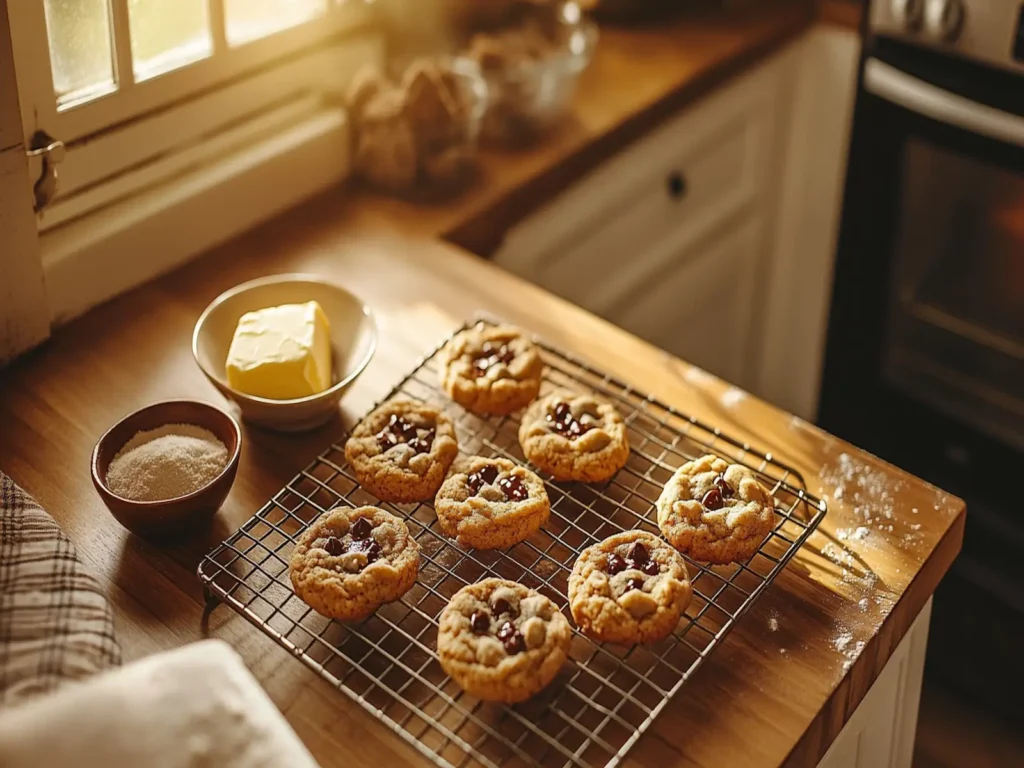Introduction: Soft and Chewy Cookies
If you’ve ever wondered how bakeries achieve those perfectly soft and chewy cookies, you’re not alone. Whether you’re trying to bake your favorite Nestle chocolate chip cookies or experimenting with a new recipe, the secret to a soft and chewy texture lies in a few key ingredients and techniques. In this guide, we’ll explore what makes cookies soft, why certain ingredients matter, and how to avoid common pitfalls.

1. Choosing the Right Ingredients
The foundation of any great cookie is its ingredients. Here’s how they affect the final texture:
- Butter vs. Margarine: Use unsalted butter for best results. Butter creates a soft and chewy texture because of its fat content, while margarine can make cookies a bit crispier.
- Brown Sugar: Brown sugar is packed with molasses, which attracts moisture and helps keep cookies soft and chewy.
- Flour: All-purpose flour works best for cookies, but be careful with the amount you use. Too much flour can make cookies dry and tough.
For more about baking basics and ingredient substitutions, check out this detailed baking guide on ingredients from Better Homes & Gardens.
2. How to Perfect Your Cookie Dough for Soft and Chewy Texture
How you prepare your dough can make a big difference in the texture of your cookies. Here are some tips:
- Chill the Dough for Extra Softness: Let your cookie dough chill in the fridge for at least 30 minutes before baking. This helps the cookies maintain their shape and results in a chewy texture.
- Don’t Overmix Dough: When mixing the dough, avoid overworking it. Overmixing activates the gluten in the flour, which can result in tough cookies.
- Add Cornstarch for a Softer Cookie: Some bakers recommend adding a teaspoon of cornstarch to the dough to achieve that extra-soft texture.
If you’re interested in experimenting with flavors, try the Earl Grey Cookies for a unique twist on your classic cookie recipes. For further reading on how to achieve the best cookie texture, you can also explore this article on Food Network’s Cookie Baking Tips.
3. Baking at the Perfect Temperature for Soft and Chewy Cookies
Getting the perfect soft and chewy cookie comes down to baking at the right time and temperature:
- Temperature Matters for Soft Cookies: Bake cookies at 350°F (175°C) for most cookie recipes. Make sure your oven is preheated properly for even baking.
- Underbake for the Chewy Cookie Effect: Remove cookies from the oven when they’re slightly underdone. The cookies will continue to cook on the baking sheet as they cool, creating that perfect soft center.
For an alternative approach to baking, you might want to check out this Pumpkin Banana Loaf for a soft and moist treat that also requires precision in baking.
4. Why Overbaking Ruins Soft and Chewy Cookies
One of the most common mistakes when baking cookies is overbaking. Here’s how to avoid that mistake:
- Watch for Golden Edges: The cookies should have golden edges but still look slightly underbaked in the center.
- Leave Space for Spreading: Cookies need room to spread, so be sure to space them out properly on the baking sheet.
Check out the Why Do My Nestle Chocolate Chip Cookies Go Flat? guide for more baking tips on cookie texture issues. You can also read this helpful post from The Kitchn on how to fix flat cookies.
5. How to Store Soft and Chewy Cookies for Maximum Freshness
Once your cookies are baked, how you store them is essential to maintaining their soft and chewy texture:
- Use Airtight Containers for Softness: Store your cookies in an airtight container to prevent them from drying out.
- Add a Slice of Bread to Keep Cookies Soft: Placing a slice of bread in the cookie jar can help keep the cookies moist. The bread absorbs any moisture from the air, preventing the cookies from getting hard.
For more storage tips, you can refer to this Storage and Preservation Guide from Serious Eats.
6. Common Mistakes to Avoid
While baking cookies may seem simple, there are a few common mistakes that can prevent them from turning out soft and chewy:
- Using Too Much Flour: Measure your flour properly. Too much flour can result in dry, crumbly cookies.
- Skipping the Chilling Process: Don’t skip chilling the dough. It’s essential for both the texture and shape of the cookies.
- Overbaking: As mentioned earlier, overbaking cookies will make them dry and crunchy instead of soft and chewy.
By following these tips and tricks, you can make delicious soft and chewy cookies that rival the ones from your favorite bakery. If you want to learn more about specific recipes or further enhance your baking skills, consider checking out these other posts on RecipeVia for inspiration.
Happy baking!

